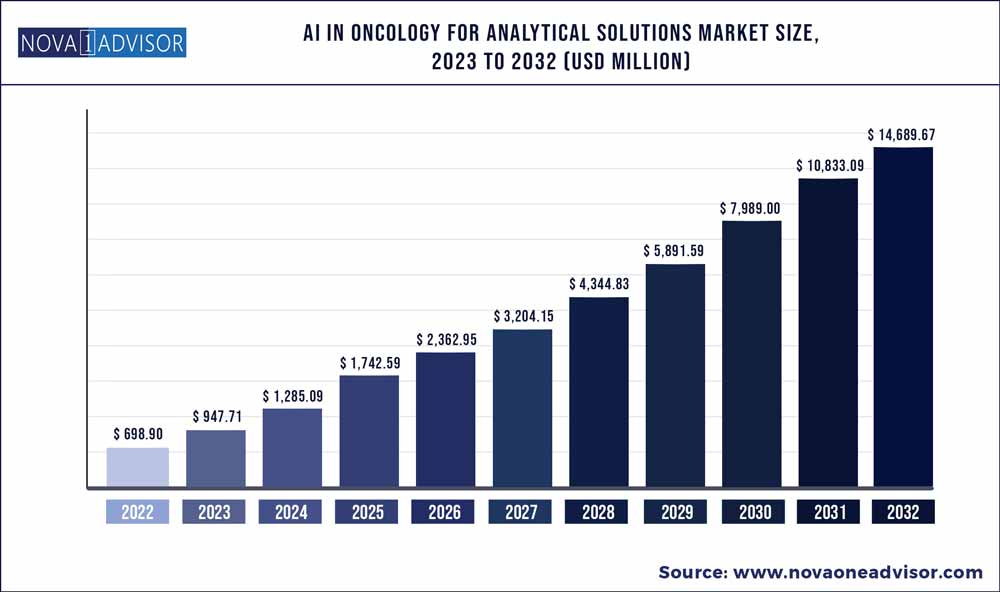The global AI in oncology for analytical solutions market size was exhibited at USD 698.9 million in 2022 and is projected to hit around USD 14,689.67 million by 2032, growing at a CAGR of 35.6% during the forecast period 2023 to 2032.

Key Pointers:
- North America dominated the market in 2022 with a share of over 58.19%.
- Asia Pacific is projected to witness the fastest growth over the forecast period from 2023 to 2032.
- The breast cancer dominated with a share of 30.18% in 2022.
- The bladder cancer segment is anticipated to witness the fastest growth over the forecast period from 2023 to 2032
- In 2022, the software solution segment accounted for the highest share of 57.11% in the market
- The data licensing services segment is expected to witness the fastest growth over the forecast period from 2023 to 2030.
AI In Oncology For Analytical Solutions Market Report Scope
| Report Coverage |
Details |
| Market Size in 2023 |
USD 947.71 million |
| Market Size by 2032 |
USD 14,689.67 million |
| Growth Rate From 2023 to 2032 |
CAGR of 35.6% |
| Base Year |
2022 |
| Forecast Period |
2023 to 2032 |
| Segments Covered |
Cancer Type, Component |
| Market Analysis (Terms Used) |
Value (US$ Million/Billion) or (Volume/Units) |
| Regional Scope |
North America; Europe; Asia Pacific; Central and South America; the Middle East and Africa |
| Key Companies Profiled |
Azra AI; IBM; Siemens Healthineers; Intel; GE Healthcare; NVIDIA; Digital Diagnostics Inc.; Concert.AI; Median Technologies; Path AI |
The increasing demand to reduce healthcare costs is expected to be a crucial factor driving the adoption of artificial intelligence (AI) in oncology for analytical solutions. The implementation of artificial intelligence algorithms in oncology can significantly improve the accuracy of procedures and reduce the costs associated with treatment by avoiding unnecessary tests. For instance, a June 2021 study published in Frontiers found that incorporating artificial intelligence in the diagnosis of colorectal cancer helped save around USD 400 million, primarily due to the early detection of cancer.
The high prevalence of cancer-related diseases worldwide is expected to drive the expansion during the forecast period. For example, the American Cancer Society, Inc. estimates that by the end of 2022, there will be nearly 1.9 million new diagnoses and 609,360 cancer-related deaths in the U.S. Additionally, lung, breast, rectal, and colon cancers were the most common cancers in February 2022, according to the World Health Organization. Moreover, a third of global cancer deaths are attributed to high body mass index, tobacco use, and lack of physical activity. Therefore, the increasing prevalence of this disease globally is expected to increase the adoption of artificial intelligence for more accurate diagnosis, contributing to the growth of the AI in oncology analytical solutions market.
The market is anticipated to grow due to improvements in healthcare infrastructure and the increasing prevalence of cancer. By utilizing artificial intelligence technology, healthcare providers can diagnose and plan treatment procedures with greater ease. The use of artificial intelligence enables earlier and more accurate detection, reducing treatment costs and enhancing the patient experience through personalized treatment. Additionally, the growth is fueled by initiatives from government and non-government organizations that invest in healthcare R&D. For instance, the Indian government plans to introduce healthcare infrastructure programs worth USD 6.19 billion, according to a recent report from IBEF.
The key players in the AI in the oncology for analytical solutions market are engaging in various strategies including mergers, acquisitions, product launches, and collaboration, which is expected to drive growth during the forecast period. For instance, in November 2022, RadNet, Inc., a provider of cost-effective, high-quality outpatient diagnostic imaging services, announced that its subsidiary Aidence, which specializes in lung artificial intelligence, has entered into an agreement with Google Health, to license later artificial intelligence research model for predicting lung nodule malignancy on CT imaging. Aidence will further develop and validate the model, and bring it to the market to support early and accurate lung cancer diagnosis, as well as reduce the need for unnecessary screening procedures. The market is also growing due to the increasing presence of new entrepreneurial startups that offer innovative solutions for treating and accurately forecasting its development. For instance, a UK-based startup the Concr is a provider of a software platform that employs a machine learning method that is based on an extensive understanding of scientific projections to forecast how tumors will progress and to more accurately predict how cancer will evolve in response to treatment.
Some of the prominent players in the AI In Oncology For Analytical Solutions Market include:
- Azra AI
- IBM
- Siemens Healthineers
- Intel
- GE Healthcare
- NVIDIA
- Digital Diagnostics Inc.
- Concert.AI
- Median Technologies
- Path AI
Segments Covered in the Report
This report forecasts revenue growth at global, regional, and country levels and provides an analysis of the latest industry trends in each of the sub-segments from 2018 to 2032. For this study, Nova one advisor, Inc. has segmented the global AI In Oncology For Analytical Solutions market.
By Component
- Data Licensing Services
- Payers
- Providers
- Pharmaceuticals
- Software Solutions
- Payers
- Providers
- Pharmaceuticals
- Analytics and Other Services
- Payers
- Providers
- Pharmaceuticals
By Cancer Type
- Breast Cancer
- Lung Cancer
- Prostate Cancer
- Colorectal Cancer
- Brain Tumor
- Kidney Cancer
- Non-Hodgkin Lymphoma
- Bladder Cancer
By Region
- North America
- Europe
- Asia-Pacific
- Latin America
- Middle East & Africa (MEA)

